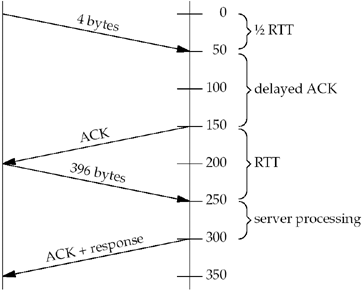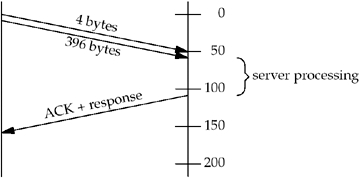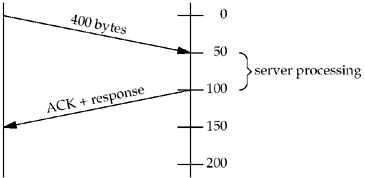Chapter 7
|
|
|
|
|
|
| 7.2
|
Figure
E.5 shows one solution to this exercise. We have removed the
printing of the data string returned by the server as that value is
not needed.
Figure E.5
Print socket receive buffer size and MSS before and after
connection establishment.
sockopt/rcvbuf.c
1 #include "unp.h"
2 #include <netinet/tcp.h> /* for TCP_MAXSEG */
3 int
4 main(int argc, char **argv)
5 {
6 int sockfd, rcvbuf, mss;
7 socklen_t len;
8 struct sockaddr_in servaddr;
9 if (argc != 2)
10 err_quit("usage: rcvbuf <IPaddress>");
11 sockfd = Socket(AF_INET, SOCK_STREAM, 0);
12 len = sizeof(rcvbuf);
13 Getsockopt(sockfd, SOL_SOCKET, SO_RCVBUF, &rcvbuf, &len);
14 len = sizeof(mss);
15 Getsockopt(sockfd, IPPROTO_TCP, TCP_MAXSEG, &mss, &len);
16 printf("defaults: SO_RCVBUF = %d, MSS = %d\n", rcvbuf, mss);
17 bzero(&servaddr, sizeof(servaddr));
18 servaddr.sin_family = AF_INET;
19 servaddr.sin_port = htons(13); /* daytime server */
20 Inet_pton(AF_INET, argv[1], &servaddr.sin_addr);
21 Connect(sockfd, (SA *) &servaddr, sizeof(servaddr));
22 len = sizeof(rcvbuf);
23 Getsockopt(sockfd, SOL_SOCKET, SO_RCVBUF, &rcvbuf, &len);
24 len = sizeof(mss);
25 Getsockopt(sockfd, IPPROTO_TCP, TCP_MAXSEG, &mss, &len);
26 printf("after connect: SO_RCVBUF = %d, MSS = %d\n", rcvbuf, mss);
27 exit(0);
28 }
First, there is no "correct" output from this
program. The results vary from system to system. Some systems
(notably Solaris 2.5.1 and earlier) always return 0 for the socket
buffer sizes, preventing us from seeing what happens with this
value across the connection.
With regard to the MSS, the value printed before
connect is the implementation default (often 536 or 512),
while the value printed after connect depends on a
possible MSS option from the peer. On a local Ethernet, for
example, the value after connect could be 1,460. After a
connect to a server on a remote network, however, the MSS
may be similar to the default, unless your system supports path MTU
discovery. If possible, run a tool like tcpdump (Section
C.5) while the program is running to see the actual MSS option on
the SYN segment from the peer.
With regard to the socket receive buffer size,
many implementations round this value up after the connection is
established to a multiple of the MSS. Another way to see the socket
receive buffer size after the connection is established is to watch
the packets using a tool like tcpdump and look at TCP's
advertised window.
|
|
|
|
| 7.3
|
Allocate a linger structure named
ling and initialize it as follows:
str_cli(stdin, sockfd);
ling.l_onoff = 1;
ling.l_linger = 0;
Setsockopt(sockfd, SOL_SOCKET, SO_LINGER, &ling, sizeof(ling));
exit(0);
This should cause the client TCP to terminate
the connection with an RST instead of the normal four-segment
exchange. The server child's call to readline returns an
error of ECONNRESET and the message printed is as
follows:
readline error: Connection reset by peer
The client socket should not go through the
TIME_WAIT state, even though the client did the active close.
|
|
|
|
| 7.4
|
The first client calls setsockopt,
bind, and connect. But between the first client's
calls to bind and connect, if the second client
calls bind, EADDRINUSE is returned. But as soon
as the first client connects to the peer, the second client's
bind will work, since the first client's socket is then
connected. The only way to handle this is for the second client to
try calling bind multiple times if EADDRINUSE is
returned, and not give up the first time the error is returned.
|
|
|
|
| 7.5
|
We run the program on a host with multicast
support (MacOS X 10.2.6).
macosx % sock -s 9999 & start first server with wildcard
[1] 29697
macosx % sock -s 172.24.37.78 9999 try second server, but without -A
can't bind local address: Address already in use
macosx % sock -s -A 172.24.37.78 9999 & try again with -A; works
[2] 29699
macosx % sock -s -A 127.0.0.1 9999 & third server with -A; works
[3] 29700
macosx % netstat -na | grep 9999
tcp4 0 0 127.0.0.1.9999 *.* LISTEN
tcp4 0 0 172.24.37.78.9999 *.* LISTEN
tcp4 0 0 *.9999 *.* LISTEN
|
|
|
|
| 7.6
|
We first try on a host that supports
multicasting, but does not support the SO_REUSEPORT option
(Solaris 9).
solaris % sock -s -u 8888 & first one starts
[1] 24051
solaris % sock -s -u 8888
can't bind local address: Address already in use
solaris % sock -s -u -A 8888 & try second again with -A; works
solaris % netstat -na | grep 8888 we can see the duplicate bindings
*.8888 Idle
*.8888 Idle
On this system, we do not need to specify
SO_REUSEADDR for the first bind, only for the second.
Finally, we run this scenario under MacOS X
10.2.6, which supports multicasting and the SO_REUSEPORT
option. We first try SO_REUSEADDR for both servers, but
this does not work.
macosx % sock -u -s -A 7777 &
[1] 17610
macosx % sock -u -s -A 7777
can't bind local address: Address already in use
Next we try SO_REUSEPORT, but only for
the second server, not for the first. This does not work since a
completely duplicate binding requires the option for all sockets
that share the binding.
macosx % sock -u -s 8888 &
[1] 17612
macosx % sock -u -s -T 8888
can't bind local address: Address already in use
Finally we specify SO_REUSEPORT for
both servers, and this works.
macosx % sock -u -s -T 9999 &
[1] 17614
macosx % sock -u -s -T 9999 &
[2] 17615
macosx % netstat -na | grep 9999
udp4 0 0 *.9999 *.*
udp4 0 0 *.9999 *.*
|
|
|
|
| 7.7
|
This does nothing because ping uses an ICMP
socket and the SO_DEBUG socket option affects only TCP
sockets. The description for the SO_DEBUG socket option
has always been something generic such as "this option enables
debugging in the respective protocol layer," but the only protocol
layer to implement the option has been TCP.
|
|
|
|
| 7.8
|
Figure
E.6 shows the timeline.

|
|
|
|
| 7.9
|
Setting the TCP_NODELAY socket option
causes the data from the second write to be sent
immediately, even though the connection has a small packet
outstanding. We show this in Figure E.7. The total time in this example is
just over 150 ms.

|
|
|
|
| 7.10
|
The advantage to this solution is reducing the
number of packets, as we show in Figure E.8.

|
|
|
|
| 7.11
|
Section 4.2.3.2 states: "The delay MUST be less
than 0.5 seconds, and in a stream of full-sized segments, there
SHOULD be an ACK for at least every second segment."
Berkeley-derived implementations delay an ACK by at most 200 ms
(p.821 of TCPv2).
|
|
|
|
| 7.12
|
The server parent in Figure 5.2 spends most
of its time blocked in the call to accept and the child in
Figure 5.3 spends most
of its time blocked in the call to read, which is called
by readline. The keep-alive option has no effect on a
listening socket so the parent is not affected should the client
host crash. The child's read will return an error of
ETIMEDOUT, sometime around two hours after the last data
exchange across the connection.
|
|
|
|
| 7.13
|
The client in Figure 5.5 spends most
of its time blocked in the call to fgets, which in turn is
blocked in some type of read operation on standard input within the
standard I/O library. When the keep-alive timer expires around two
hours after the last data exchange across the connection, and all
the keep-alive probes fail to elicit a response from the server,
the socket's pending error is set to ETIMEDOUT. But the
client is blocked in the call to fgets on standard input
and will not see this error until it performs a read or write on
the socket. This is one reason why we modified Figure 5.5 to use
select in Chapter 6.
|
|
|
|
| 7.14
|
This client spends most of its time blocked in
the call to select, which will return the socket as
readable as soon as the pending error is set to ETIMEDOUT
(as we described in the previous solution).
|
|
|
|
| 7.15
|
Only two segments are exchanged, not four. There
is a very low probability that the two systems will have timers
that are exactly synchronized; hence, one end's keep-alive timer
will expire shortly before the other's. The first one to expire
sends the keep-alive probe, causing the other end to ACK this
probe. But the receipt of the keep-alive probe causes the
keep-alive timer on the host with the (slightly) slower clock to be
reset for two hours in the future.
|
|
|
|
| 7.16
|
The original sockets API did not have a
listen function. Instead, the fourth argument to
socket contained socket options, and SO_ACCEPTCON
was used to specify a listening socket. When listen was
added, the flag stayed around, but it is now set only by the kernel
(p.456 of TCPv2).
|

|